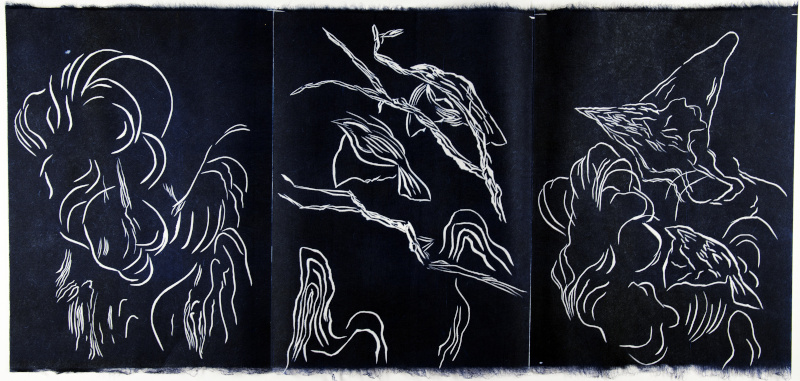
Birds as creatures of immanence
by Paul Uhlmann
- View Paul Uhlmann's Biography
Paul Uhlmann is an artist and educator in Visual Arts based at School of Arts and Humanities, Edith Cowan University, Perth.
Birds as creatures of immanence
Paul Uhlmann

Image credit: Paul Uhlmann, Air: Silently Birds fly through us (2020), (detail) Artist's book, leporello, linocut, 200 cm (length) x 27 cms (height)
We will say of pure immanence that it is A LIFE, and nothing else.
(Deleuze, 27)
Since the very beginning of my practice birds have occupied a unique place within my art as creatures which conceptually open portals to immanence. In contrast, within art history, birds often carry a symbolic function of transcendence — of being creatures outside of our lives, linking heaven and earth as messengers from God; in a painting by Velázquez for example Saints Anthony Abbot and Paul the Hermit (1634), a Raven brings the daily bread to the hermit as a gift from God (Velázquez). More often in contemporary art depictions of birds enact something of a double movement which implies that the audience pay attention to birds as significant actors — perhaps carrying a message — however an overriding understanding is that they are very much part of the organic whole of Nature, the stuff of matter, which will ultimately lose this ability to ascend to the sky and decay into the earth.
To think through What is Philosophy? by Gilles Deleuze and Felix Guattari the ecological logic of the plane of immanence can be imagined as a plateau where all forms of life emerge and are deeply interconnected — there is no hierarchy on such a plane — rather everything flows and is in constant flux. There is no higher order or transcendental field, rather all of life pulsates through creative and destructive cycles across a range of multiplicities and folds back into itself endlessly. With such a univocal image there are no borders between self and world, humanity dissolves seamlessly into a unified, restless field of constant change. We are habituated through language to see ourselves as separate from the world, to stand apart from nature and to frame our existence through a Cartesian lens where mind is separate from body; I have often found however that it is possible to momentarily return to pre-conscious understandings, to slide into univocal experiences, so that when a bird darts by one's shoulder the self vanishes, and merges with the existence of the bird. In a micro-moment one becomes that bird, and in the truest sense our lives are inter-dependent.
![1 - PaulUhlmann_image 2_ landscape, landscape ( smoke) _2019 jpg[1].jpg](/cms_images/452_10-04-2023_7157.jpg)
Image credit: Paul Uhlmann, Landscape, Landscape (Smoke), 2019, oil on canvas, 112 x 152cm (diptych)
![3 - PaulUhlmann_image 3_landscape, landscape (birds)[1].jpg](/cms_images/452_10-04-2023_5929.jpg)
Image credit: Paul Uhlmann, Landscape, Landscape (Birds), 2020, oil on canvas, 110 x 71cm
The fires would not go out
Just before Christmas in 2019 I was visiting my family in Sydney and together with a friend and my ten-year-old daughter we roamed Taronga zoo sketching animals. The day before this major city had been shrouded in black smoke and newspapers carried photographs untypical of Sydney with people crossing streets wearing face masks (Guardian). As we drew tiny creatures in the nocturnal cavern, we shuddered at the thought of how these delicate beings would handle the intense fires that ranged across the eastern sea board. Scanning my phone later that night I saw that Australia was a hot bed of burning spot fires, dotted across the nation. A week later, as we flew back to Perth the fires continued, indeed they refused to go out for many months and the smoke carried across the globe stretched to Chile South America (Reuters); the smoke was not only the habitat of the creatures but the remains of the creatures themselves. The fires were unprecedented; indeed, the world wildlife fund estimates that 3 billion animals, including 180 million birds were destroyed or displaced by the fires (WWF). Nobody could think that this was a usual seasonal event; it was a much more dire warning. The CEO of WWF Australia described it as ..."one of the worst wildlife disasters in modern history" (WWF).
The images that accompany this text carry the urgent message that humanity is deeply intertwined with nature, so what we do to the environment we do to ourselves. These images were made in response to the fires of 2019—2020 which engulfed Australia and seemed to have no end in sight.
![2 - PaulUhlmann_image 4_land of smoke ( owl)_ 2020jpg[1].jpg](/cms_images/452_10-04-2023_3584.jpg)
Image credit: Paul Uhlmann, Land of Smoke (Owl), 2020, oil on canvas, 91 x 61cm
Works Cited
Deleuze, Gilles. Pure Immanence: Essays on a Life. Translated by Anne Boyman, Zone Books, 2001.
Deleuze, Gilles, and Felix Guattari. What Is Philosophy? Translated by Graham Burchell and Hugh Tominson, Verso, 2003.
Guardian. "More homes threatened by NSW bushfires as hazardous smoke blankets Sydney." Guardian, 04 Dec 2019.
Reuters. "Australian Bushfire Smoke Drifts to South America, UN Reports," The Guardian, 8 January 2020.
Velázquez, Diego Rodríguez de Silva y. Saints Anthony Abbot and Paul the Hermit (1634), Museuo del Prado,
World Wildlife Fund. "New WWF report: 3 billion animals impacted by Australia's bushfire crisis". 28 Jul 2020.

